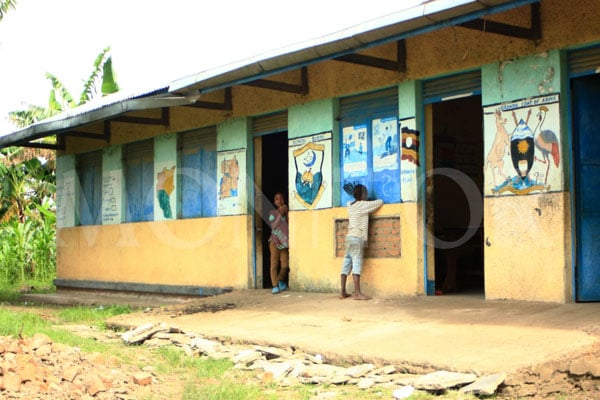Prime
The govt school with five pupils, 12 teachers

Two of the five pupils at Kenyange Muslim Primary School in Karusandara Sub-county, Kasese District. PHOTO/JOEL KAGUTA
What you need to know:
- Floods and the impact of the pandemic forced many learners to abandon the school.
The village path leading to Kenyange Muslim Primary School in Kasese District is narrow, winding and bushy. The largely-uninhabited neighbourhood looks forlorn, the residents having fled when nearby Sebwe River burst its banks and wreaked havoc early this year, as it has done in the past.
With two blocks and five classrooms, five pupils and 12 teachers, the school is the rarest of a government-aided institution. Many schools in the country struggle to meet the staff ceiling, leading to teacher to pupil ratio crossing the national average of 1:46, but for Kenyange Muslim, there too many teachers and fewer-than-expected learners. Only three boys and two girls.
When this publication visited last Friday, both girls were absent. The deputy head teacher, Mr Faishal Muhindo, laboured to teach the only Primary Three pupil.
Two of the learners are in Primary One while the others in P.2. None of those present wore uniform. According to the school administrators, pressing for add-ons without supporting student population is unhelpful and potentially counter-productive. They fear strictness could boomerang, with the five learners quitting altogether.
The explanations for the free fall in pupil numbers are many. Before Covid-19 struck, leading in Uganda’s case to closure of educational institutions for two years, the school teemed with 300 pupils. Officials records show there were 130 students by last year.
When the government reopened schools and the economy in January, most learners here were a no-show. Only 58 turned up in first term.
In accounts we could not independently corroborate, it is alleged that one of the Parent-Teachers’ Association executives moved to occupy the school’s only staff quarter building.
The administrators objected. In retaliation, the PTA executive reportedly demobilised parents from enrolling their children at the school.
“After realising that the school enrollment was reducing, I also removed my children and now they are studying at Kanaba Primary School. During rainy season, my children could suffer a lot because crossing the flooded river was risky,” Mr James Muhindo, a resident of Kabaka Village, said. There were other teething problems too. For instance, early this year, floods displaced dozens of families from the area.
Besides, there are fears in the community for safety of school-going children in an area where wild animals regularly stray from Queen Elizabeth National Park to terrorise villagers and destroy gardens.
As a result, by last term, the school had only eight pupils. Then three dropped out this term, the last for promotional examinations.
Local competition added to the blues. Karusandara Sub-county has six other government-aided primary schools - Kyabaga Muslims, Karusandara SDA, Karusandara, Kenyange, Kanaba and Kibuga.
The five pupils at Kenyange Muslim PS trek from far, by some estimates between 7 and 10 kilometres. With no accommodation on site, the dozen teachers reside even farther – in Kasese Town.
Their workload is light, their incentive scant. They show up as and when they want, said Mr Muhindo, who is struggling to hold things together in the absence of an indisposed head teacher.
“Our teachers report at school when they wish because they cannot travel from Kasese town daily to this school to teach only five pupils. Others come [and] after signing the attendance book, they go back,” he said.
The community founded the school in the 1980s to cure gaps in school access for the young ones. Located about 15 kilometres from the turn at Kisenyarazi Trading Centre on Kasese-Fort Portal Road, only village paths open the school to the world and modernisation.
Through lobbying by local leaders, the government took over the school. The district erected a structure, adding to a crumbling one the locals had built.
To glue teachers, school administrators and parents agreed to open the institution’s land up for teachers to dig. They store their farm implements in one of the classrooms.
Together with the newly-elected PTA chairman, Mr Twaha Kalifani Juma, Mr Muhindo said they agreed to introduce free meals to attract more pupils. It remained unclear how they would bankroll the feeding programme.
Mr Muhindo said he was an understudy and could not discuss financials. The government disburses Shs20,000 annually in capitation grant per pupil in primary schools it aids, meaning with only five learners, Kenyange Muslim should be receiving Shs100,000.
Leaders to transfer teachers
The chief administrative officer (CAO), Mr Elias Byamungu, said the question of how much the school gets and how it is used is now a matter of investigation.
“I am one of the longest serving CAOs, but what I found at that school I have never seen it in my life. I have directed the district education officer (DEO) to transfer all the teachers,” he said.
DEO George Mayanja said he intends to visit the school and leave only two teachers to teach the five learners as the rest are shuffled elsewhere.
Mr Herbert Bwambale, the Kasese Municipal secretary for social services, said they plan to relocate the school, adding that they have commissioned a parallel fact-finding on the institution.




